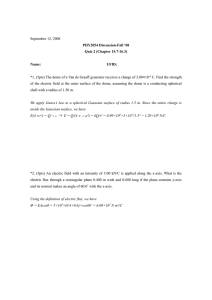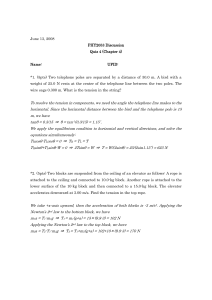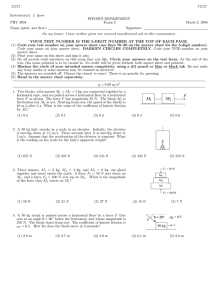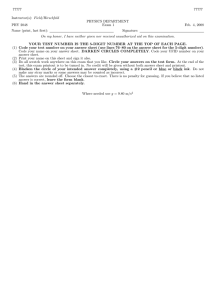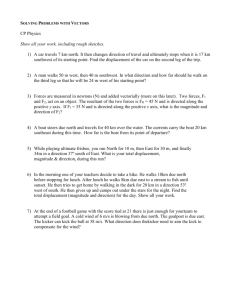June 6, 2008 PHY2053 Discussion Quiz 3 (Chapter 3)
advertisement
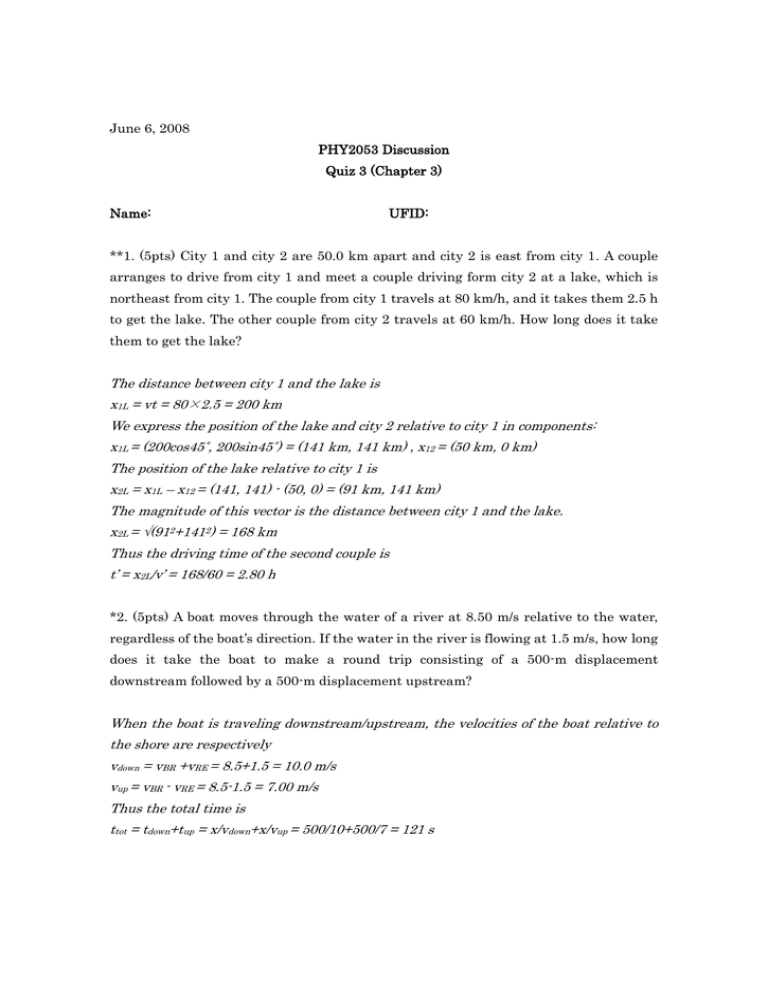
June 6, 2008 PHY2053 Discussion Quiz 3 (Chapter 3) Name: UFID: **1. (5pts) City 1 and city 2 are 50.0 km apart and city 2 is east from city 1. A couple arranges to drive from city 1 and meet a couple driving form city 2 at a lake, which is northeast from city 1. The couple from city 1 travels at 80 km/h, and it takes them 2.5 h to get the lake. The other couple from city 2 travels at 60 km/h. How long does it take them to get the lake? The distance between city 1 and the lake is x1L = vt = 80×2.5 = 200 km We express the position of the lake and city 2 relative to city 1 in components: x1L = (200cos45˚, 200sin45˚) = (141 km, 141 km) , x12 = (50 km, 0 km) The position of the lake relative to city 1 is x2L = x1L – x12 = (141, 141) - (50, 0) = (91 km, 141 km) The magnitude of this vector is the distance between city 1 and the lake. x2L = √(912+1412) = 168 km Thus the driving time of the second couple is t’ = x2L/v’ = 168/60 = 2.80 h *2. (5pts) A boat moves through the water of a river at 8.50 m/s relative to the water, regardless of the boat’s direction. If the water in the river is flowing at 1.5 m/s, how long does it take the boat to make a round trip consisting of a 500-m displacement downstream followed by a 500-m displacement upstream? When the boat is traveling downstream/upstream, the velocities of the boat relative to the shore are respectively vdown = vBR +vRE = 8.5+1.5 = 10.0 m/s vup = vBR - vRE = 8.5-1.5 = 7.00 m/s Thus the total time is ttot = tdown+tup = x/vdown+x/vup = 500/10+500/7 = 121 s **3. (5pts) A car is parked on a cliff overlooking the ocean that makes an angle of 20.0˚ below the horizontal. The car rolls from rest down the incline with a constant acceleration of 3.00 m/s2 over a distance of 40.0 m to the edge of a cliff, which is 50.0 m above the ocean. What is the car’s position relative to the base of the cliff when the car lands in the ocean? The initial velocity of the projectile motion is the velocity of the car at the edge of the cliff. Thus we have v02 = 2aL ⇒ v0 = √(2aL) = 15.5 m/s, -20˚ to the horizontal The x- and y- components of the initial velocity are (v0x, v0y) = (15.5cos(-20˚), 15.5sin(-20˚)) = (14.6 m/s, -5.30 m/s) We can calculate the time of flight using the formula for the vertical displacement. Δy = v0yt-(1/2)gt² ⇒ 4.9t²+5.3t-50 = 0 ⇒ t = (-5.3+√(5.3²+4×4.9×50))/9.8 = 2.70 s Thus the horizontal distance is Δx = v0xt = 14.6×2.7 = 39.4 m ***4. (5pts) We derived that when you throw a ball on a flat ground, you can maximize the horizontal range by throwing the ball at an angle of 45˚. Now suppose you throw a ball on a 15˚ incline. At what angle do you need to throw the ball to get the maximum range? Hint: Express the incline as Δy = Δxtanα, where α = 15˚. Find the time of flight in terms of initial velocity and projection angle, then maximize the horizontal displacement. Useful formula: sinAcosB±sinBcosA = sin(A±B). For convenience, we measure the projection angle φ from the surface of the incline. When the ball hits the incline, the horizontal and vertical displacements satisfies Δy = Δx×tanα, thus we have, v₀sin(α+φ)t-(1/2)gt² = v₀cos(α+φ)t×tanα ⇒ t = (2/g) v₀ [sin(α+φ)-cos(α+φ)tanα] = 2 v₀sinφ/(gcosα) The horizontal displacement is Δx = v₀cos(α+φ)t = v₀cos(α+φ)×2 v₀sinφ/(gcosα) = (v₀²/gcosα)[sin(2φ+α)-sinα] The sine function takes the maximum value when 2φ+α = 90˚ ⇒ φ = (90˚-α)/2 = (90-15)/2 = 37.5˚ above the incline
